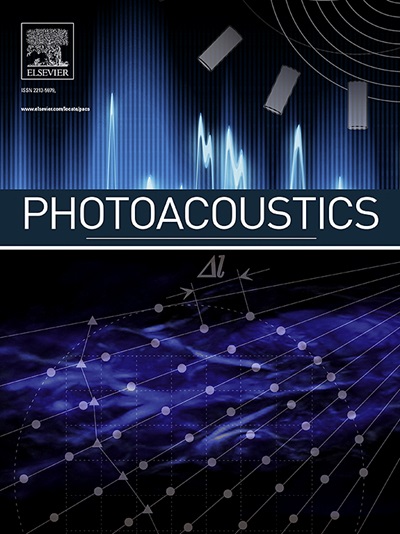光声成像在下肢血运重建术中的应用:评估围手术期肌肉灌注的新技术
IF 6.8
1区 医学
Q1 ENGINEERING, BIOMEDICAL
引用次数: 0
摘要
目的:本概念验证研究旨在评估多光谱光声断层扫描(MSOT)在评估下肢血运重建术(LER)前后下肢肌肉含氧血红蛋白(HbO2)水平变化的可行性。方法对26例患者进行LER治疗前后HbO2水平评估,随访6个月,观察患者症状控制情况及通畅程度。结果ler治疗前后下肢肌肉HbO2水平差异有统计学意义。在10例患者中,HbO2水平在LER后没有升高,在6个月的随访中,其中2例患者由于再狭窄≥ 50% %而需要进行靶病变血运重建术(TLR)。相比之下,16例患者在ler后HbO2水平升高,6个月时没有患者需要TLR。结论本研究证明了MSOT检测LER后组织灌注变化的潜力,突出了其作为指导治疗策略的新型成像方式的前景。本文章由计算机程序翻译,如有差异,请以英文原文为准。
Optoacoustic imaging in lower extremity revascularization: A novel technique to assess perioperative muscle perfusion
Objectives
This proof-of-concept study aimed to assess the feasibility of Multispectral Optoacoustic Tomography (MSOT) in evaluating changes in oxygenated hemoglobin (HbO2) levels in muscles of the lower limb before and after lower extremity revascularization (LER).
Methods
In 26 patients, HbO2 levels were assessed before and after LER, with follow-up assessing symptom control and patency for up to six months.
Results
A significant difference in HbO2 levels was observed between pre- and post-LER in the muscles of the lower limb. In 10 patients, HbO2 levels did not increase following LER, and at the 6-month follow-up, 2 of these patients required target lesion revascularization (TLR) due to restenosis of ≥ 50 % stenosis. In contrast, 16 patients demonstrated increased HbO2 levels post-LER, with no patients requiring TLR at 6-months.
Conclusion
This study demonstrates the potential of MSOT to detect changes in tissue perfusion following LER, highlighting its promise as a novel imaging modality for guiding treatment strategies.
求助全文
通过发布文献求助,成功后即可免费获取论文全文。
去求助
来源期刊

Photoacoustics
Physics and Astronomy-Atomic and Molecular Physics, and Optics
CiteScore
11.40
自引率
16.50%
发文量
96
审稿时长
53 days
期刊介绍:
The open access Photoacoustics journal (PACS) aims to publish original research and review contributions in the field of photoacoustics-optoacoustics-thermoacoustics. This field utilizes acoustical and ultrasonic phenomena excited by electromagnetic radiation for the detection, visualization, and characterization of various materials and biological tissues, including living organisms.
Recent advancements in laser technologies, ultrasound detection approaches, inverse theory, and fast reconstruction algorithms have greatly supported the rapid progress in this field. The unique contrast provided by molecular absorption in photoacoustic-optoacoustic-thermoacoustic methods has allowed for addressing unmet biological and medical needs such as pre-clinical research, clinical imaging of vasculature, tissue and disease physiology, drug efficacy, surgery guidance, and therapy monitoring.
Applications of this field encompass a wide range of medical imaging and sensing applications, including cancer, vascular diseases, brain neurophysiology, ophthalmology, and diabetes. Moreover, photoacoustics-optoacoustics-thermoacoustics is a multidisciplinary field, with contributions from chemistry and nanotechnology, where novel materials such as biodegradable nanoparticles, organic dyes, targeted agents, theranostic probes, and genetically expressed markers are being actively developed.
These advanced materials have significantly improved the signal-to-noise ratio and tissue contrast in photoacoustic methods.
 求助内容:
求助内容: 应助结果提醒方式:
应助结果提醒方式:


